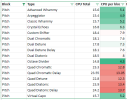Joel.Brown333
Inspired
+1000
couldn't you use the 'Advanced Whammy' model and set the 'Start' to -1, or -2, or whatever? And the 'Stop' to +11, or +10, or whatever?+1!!!
I know maybe this would be very difficult due to CPU limits, but I would also be happy to use virtual capo + whammy!
It could be using the exact same amount of CPU , that might be why they have not implemented something like this because they would essentially need 2 pitch blocksYES Please! Dedicated Virtual Capo block would do the trick! And that would not use much CPU!
Virtual Capo uses nearly the least CPU of the Pitch block options - so wouldnt be too CPU intensive. These are FM9 Turbo CPU usages per block - so FM3 would be higher.It could be using the exact same amount of CPU , that might be why they have not implemented something like this because they would essentially need 2 pitch blocks

I have quite a few presets now where I'm using pitch block 1 for some guitar harmonies. I'm also working with a few different acts that prefer 1/2 step drop tuning (Eb).
It would be so cool if we had a 2nd pitch block that if nothing else, did the virtual capo thing. Thanks for listening!
"Pitch shifting necessarily adds latency. Pitch shifting is a perceptual process. It requires a reasonable amount of history to work. This adds latency. Typically 20ms and up. Some people are more tolerant to latency than others. I've compared the latency of our algorithm to other products and ours is equal or better but there is latency in any pitch shifter. All pitch shifters have tradeoffs. The lower the latency the more prone they are to tremolo artifacts, double transients and other issues. Solving those issues increases the latency and the computational burden. The only pitch shifting algorithm that has negligible latency is the "Rollers" algorithm but that requires insane amounts of CPU and the samples I've heard aren't impressive. It also has its share of issues (smearing, chirping)." [9]
You're making an assumption that CPU is the reason... There's no evidence that it is the reason. Same as the FM9.I was just told there are “no plans to make this change”Very strange considering how long this has been a wish and the fact that Virtual Capo takes so little DSP.
I’ll add my +1 anyway
Pitch shifting takes CPU, but more than that it adds latency and a faster CPU won’t fix that because it’s tied to the need to sample the lowest string multiple times for accuracy.and the fact that Virtual Capo takes so little DSP.
The better the pitch shifting, the more the latency. It's a perceptual process. There is no mathematically perfect way to do it. Also, when you pitch shift, the sound coming from the speakers doesn't reinforce the strings (since it's at a different frequency) so you don't get sustain and feedback harmonics." [8]
"A low E has a period of about 12 ms. This means you have to buffer at least 12 ms to shift anything from low E and up. To also work with bass then low E is 24 ms."
"Pitch shifting necessarily adds latency. Pitch shifting is a perceptual process. It requires a reasonable amount of history to work. This adds latency. Typically 20ms and up. Some people are more tolerant to latency than others. I've compared the latency of our algorithm to other products and ours is equal or better but there is latency in any pitch shifter. All pitch shifters have tradeoffs. The lower the latency the more prone they are to tremolo artifacts, double transients and other issues. Solving those issues increases the latency and the computational burden. The only pitch shifting algorithm that has negligible latency is the "Rollers" algorithm but that requires insane amounts of CPU and the samples I've heard aren't impressive. It also has its share of issues (smearing, chirping)." [9]
Adding another pitch block to the FM3 would degrade the sound quality, and Cliff is definitely not about that.(FM3) "The pitch block was updated in 5.xx. The pitch detector still isn't up to Axe-Fx III standards but it still works well. There simply isn't enough horsepower to run the Axe-Fx III pitch detector without sacrificing the number of simultaneous effects. [5]
